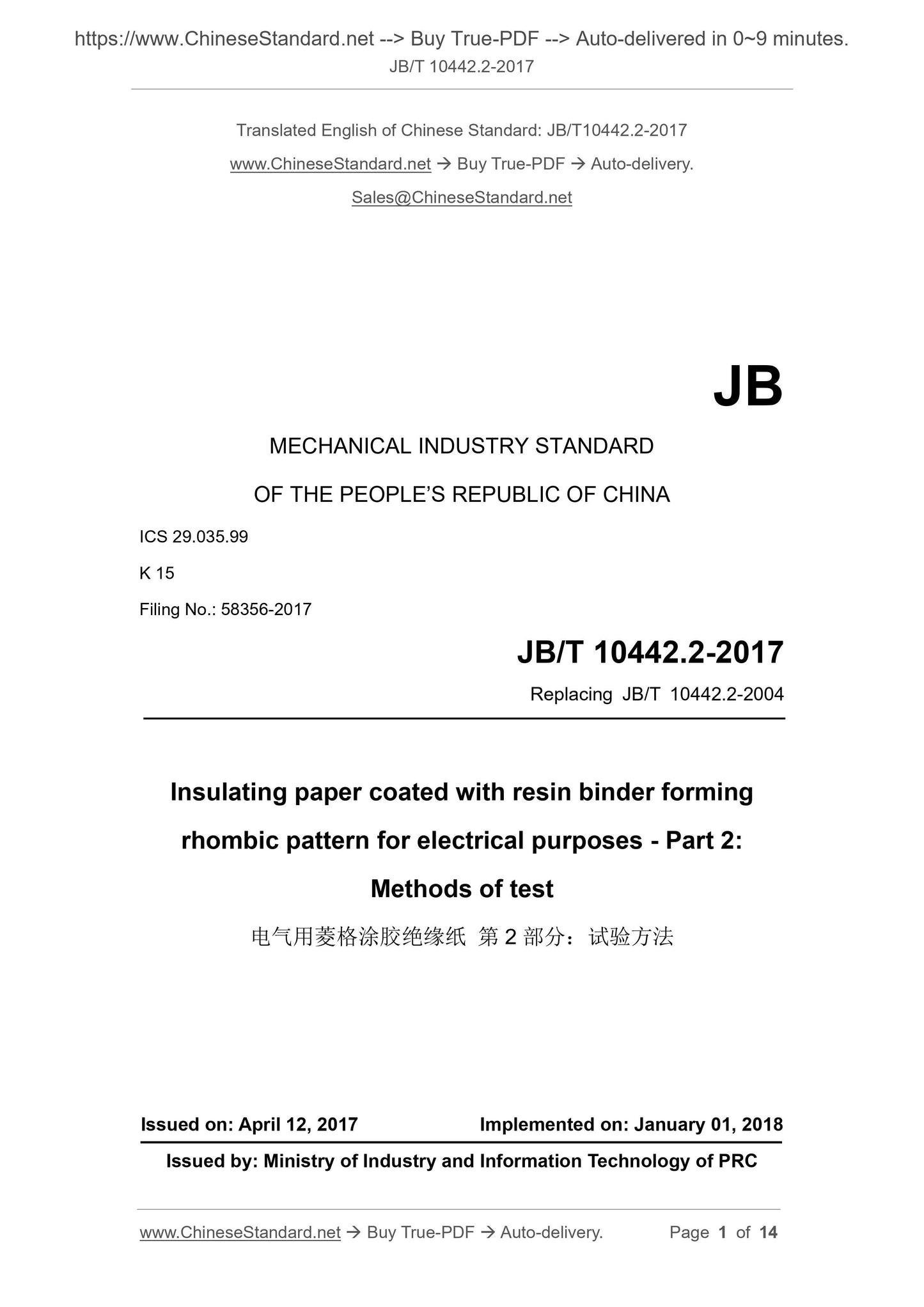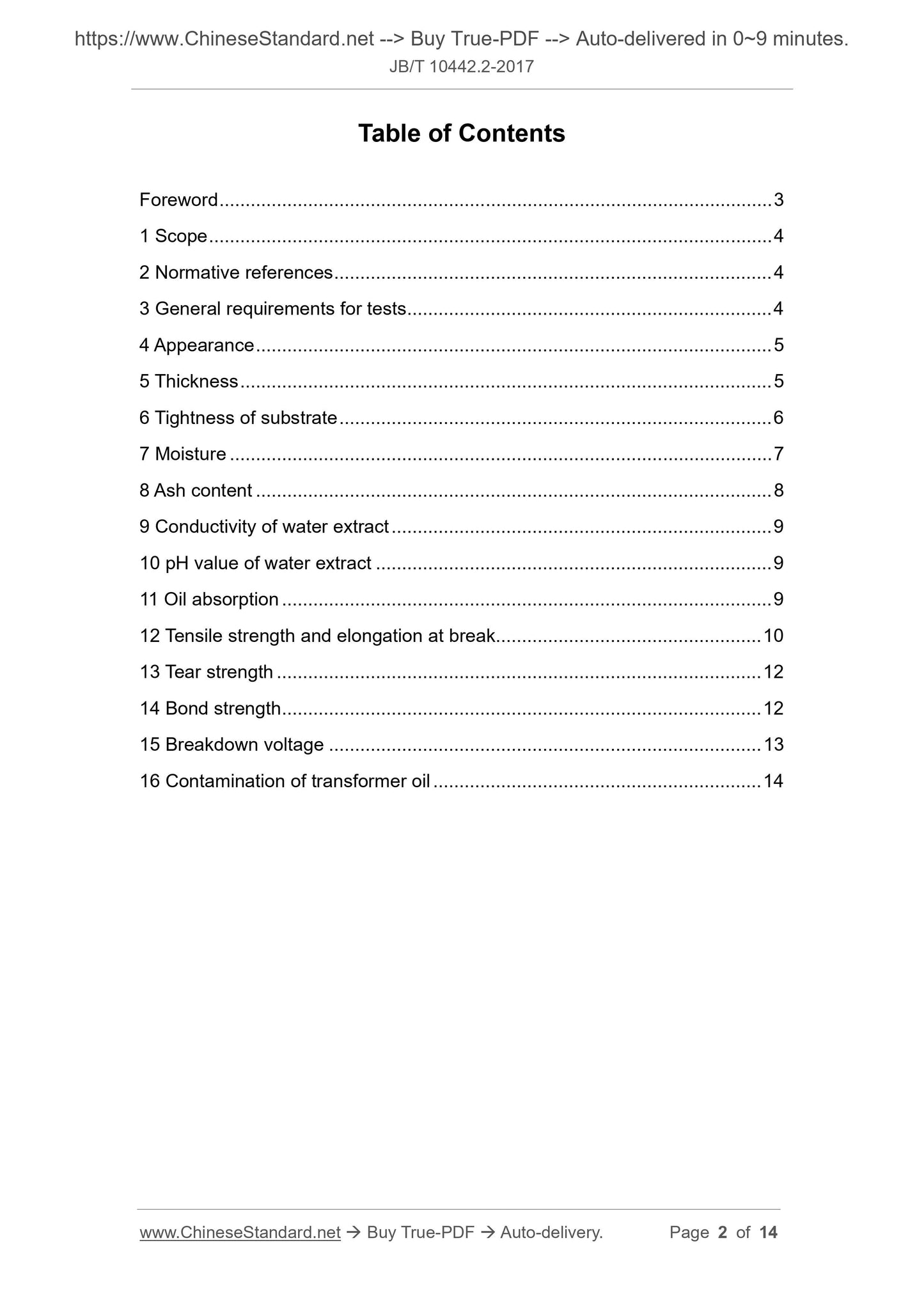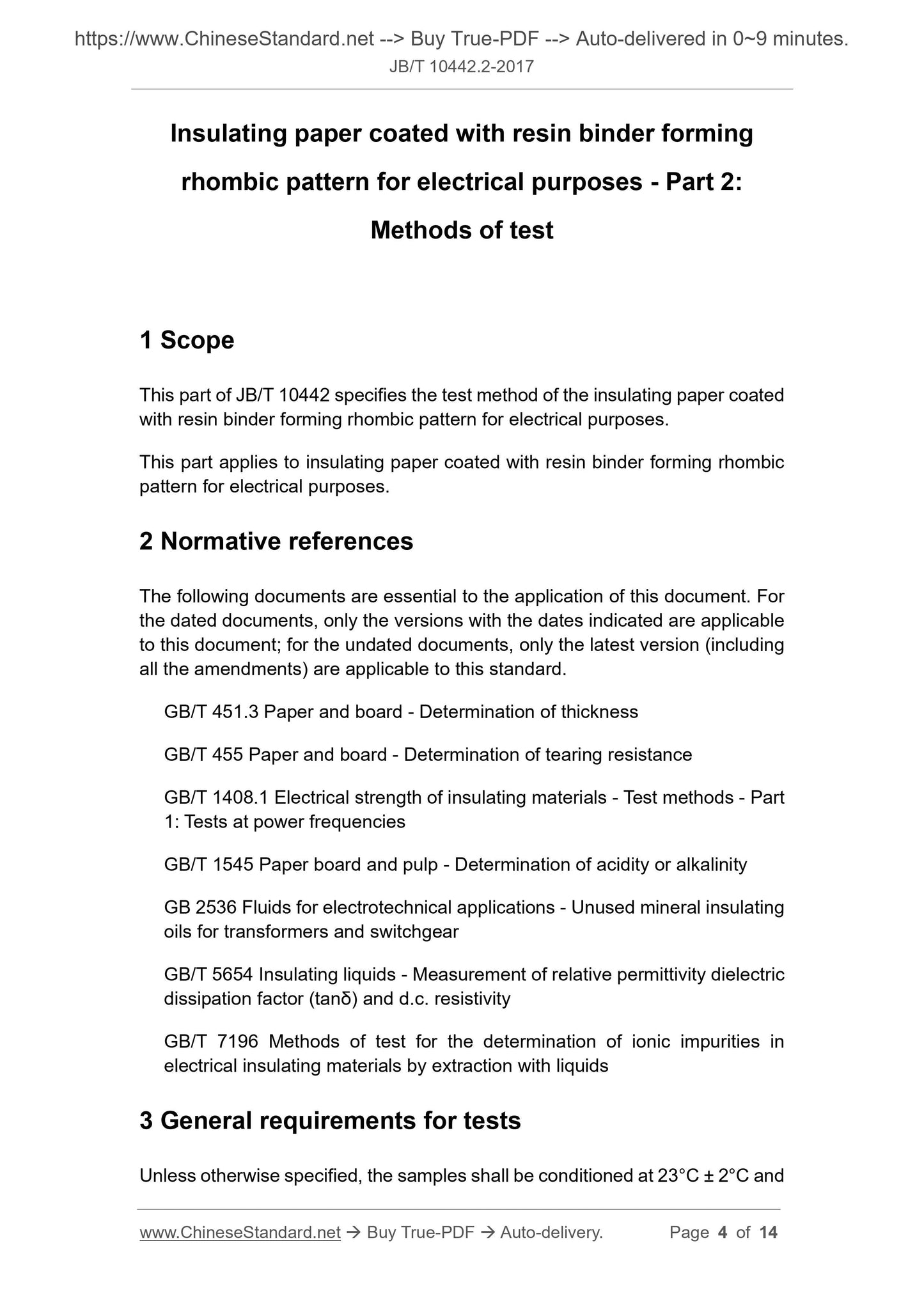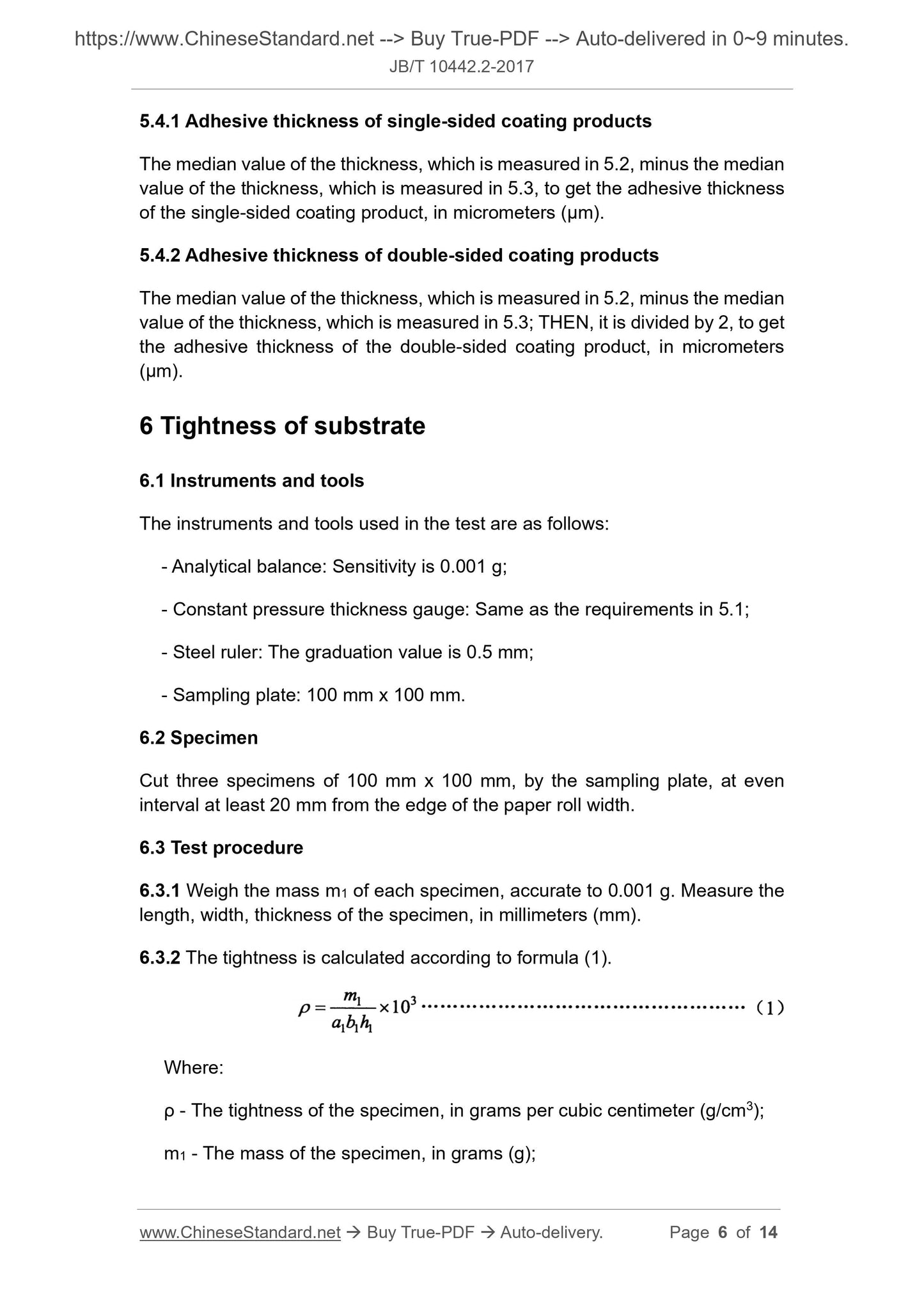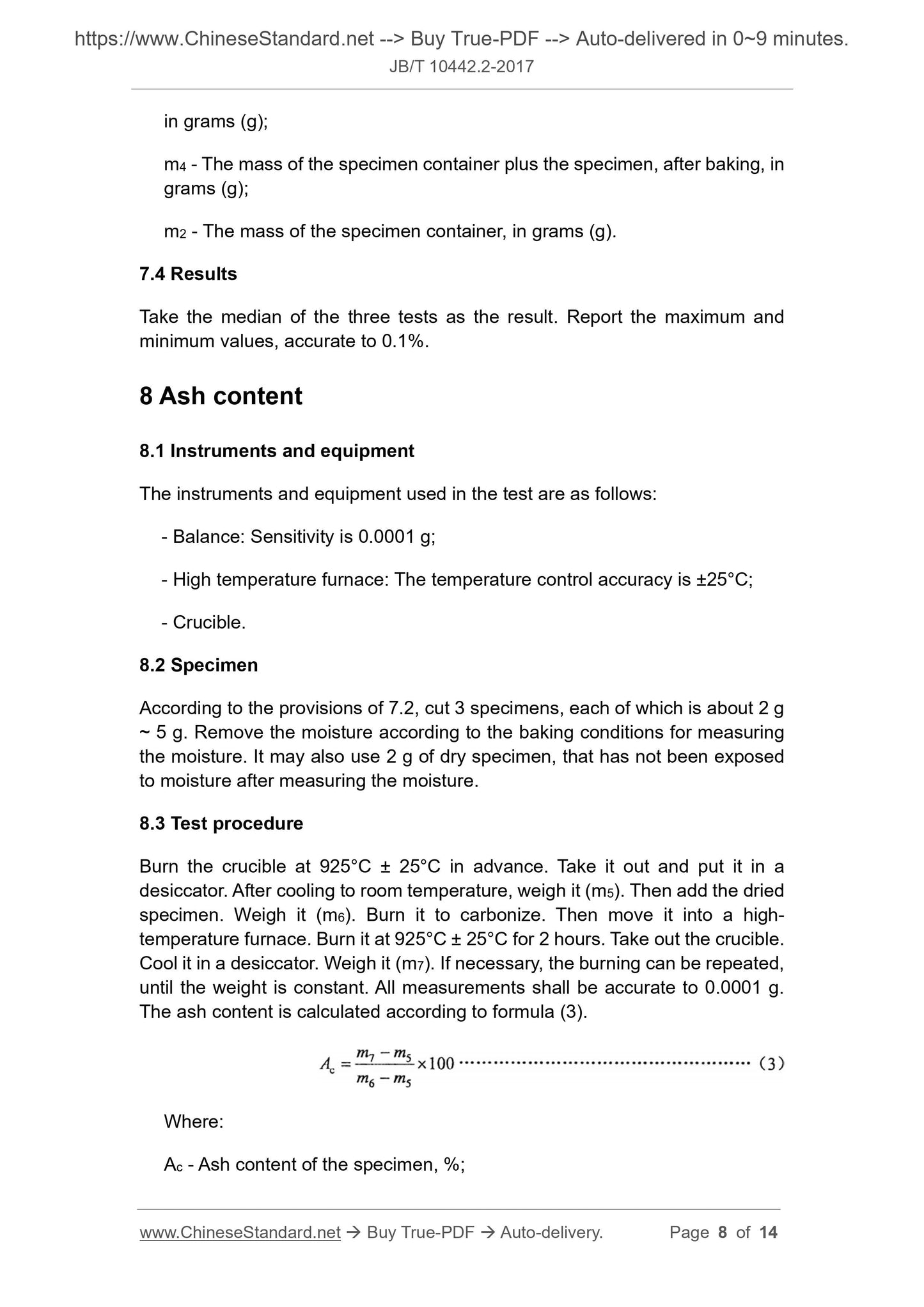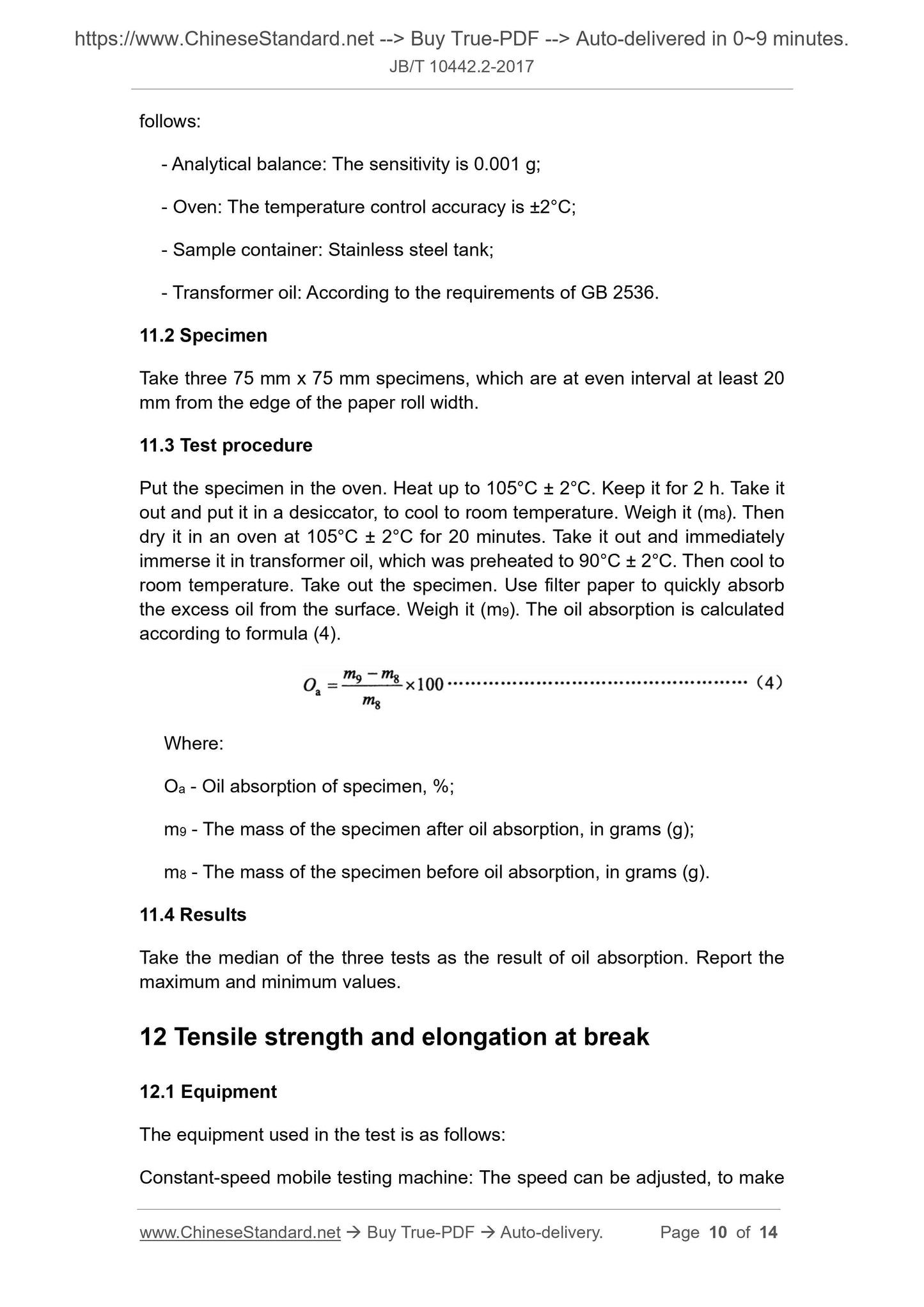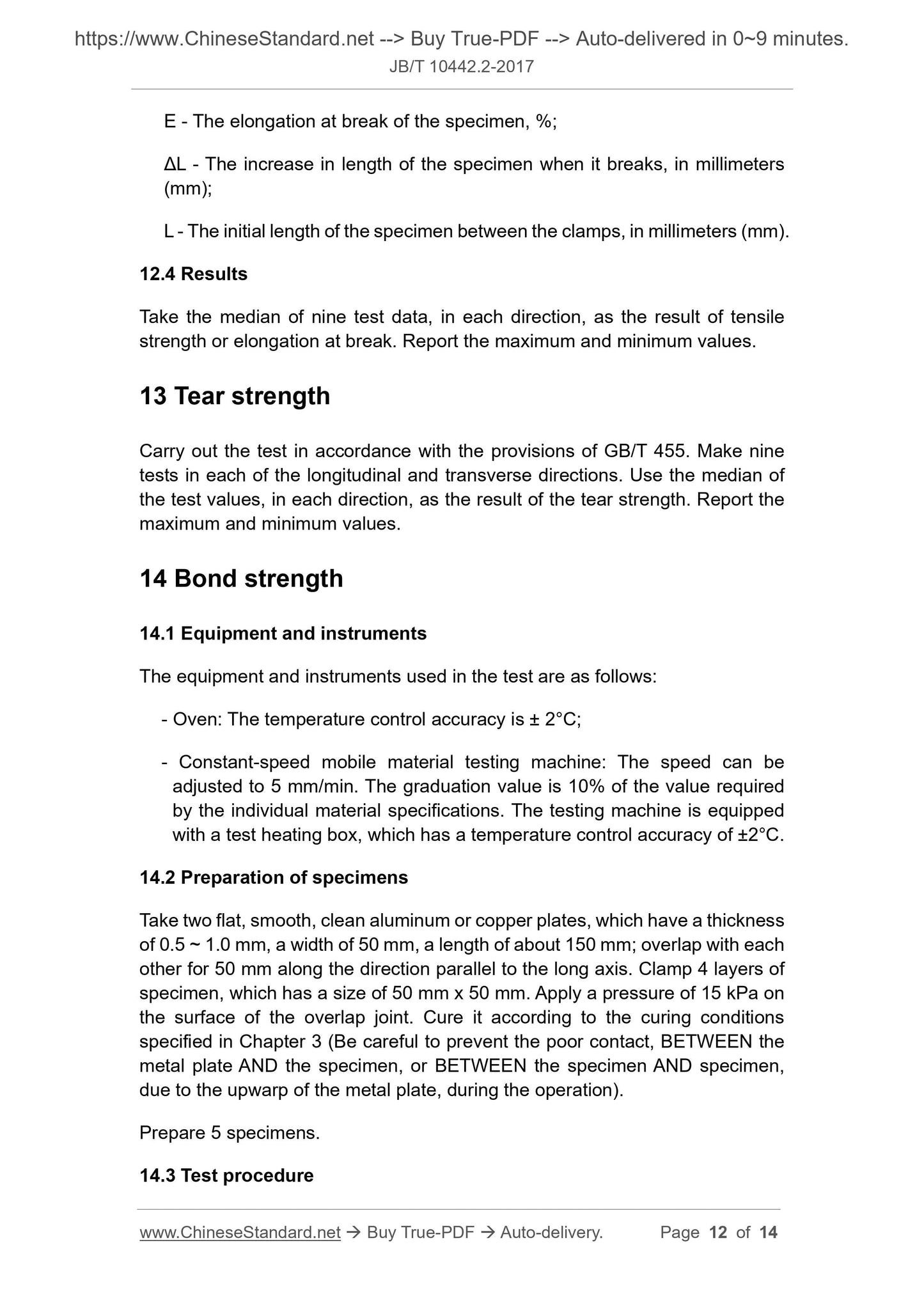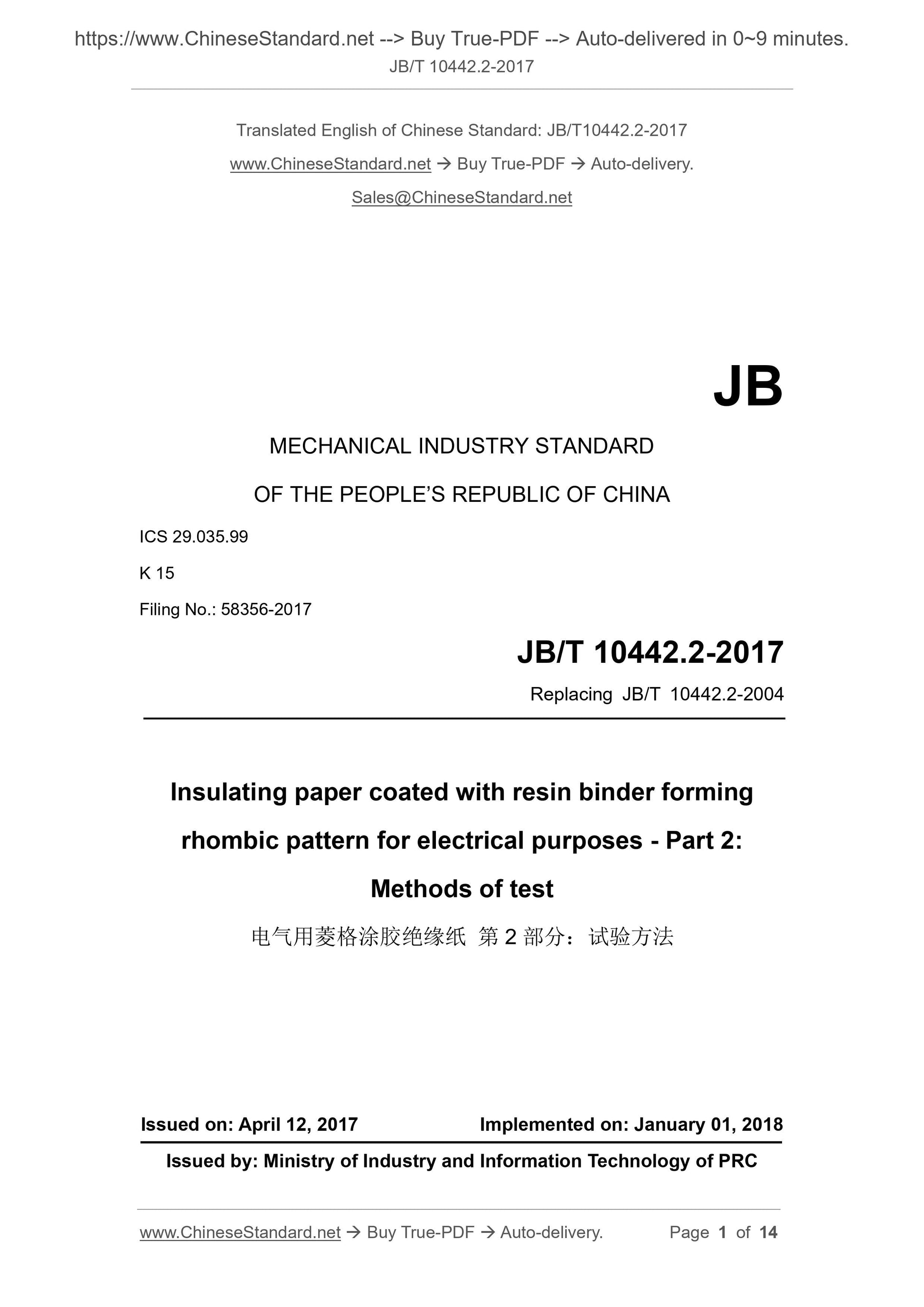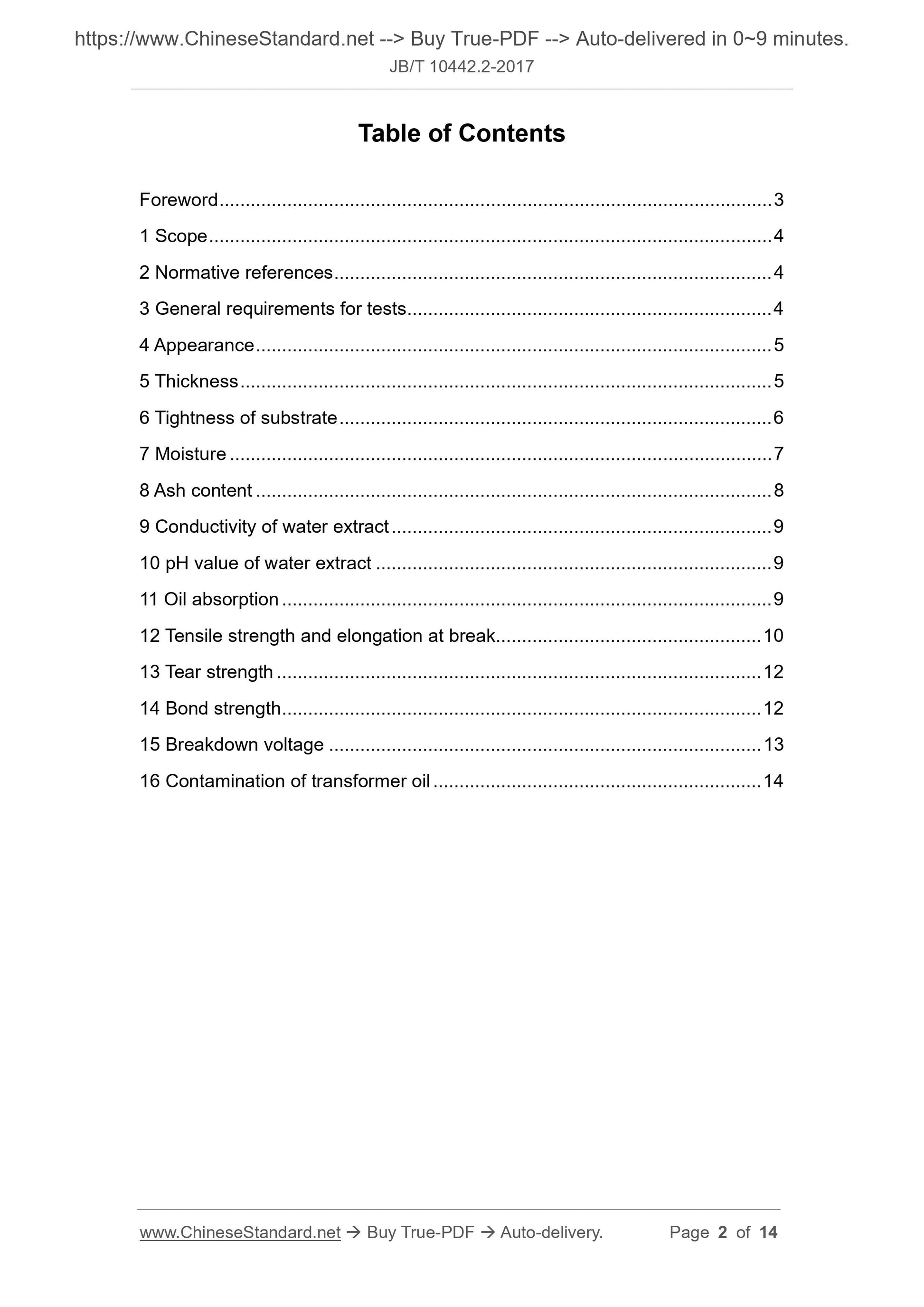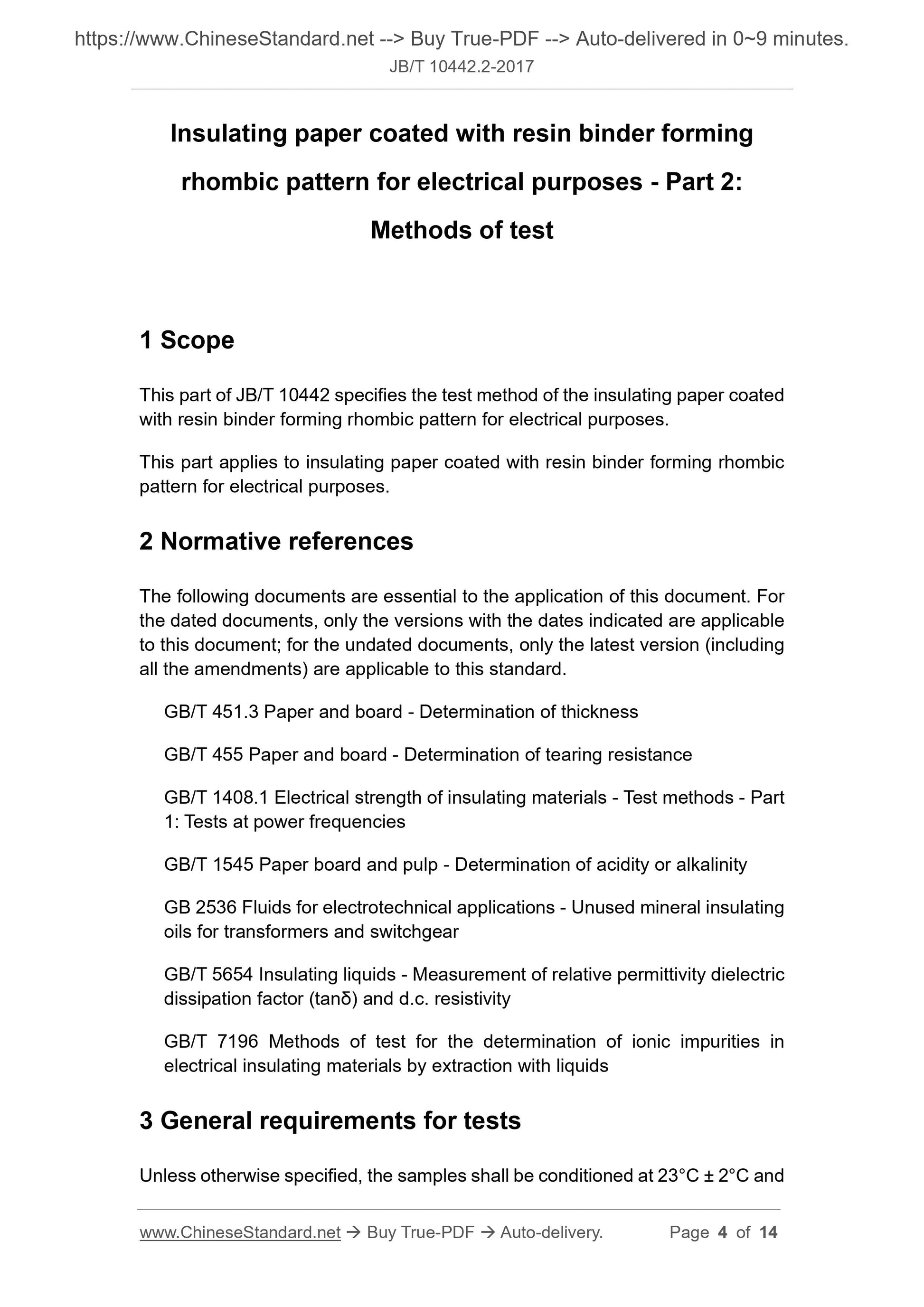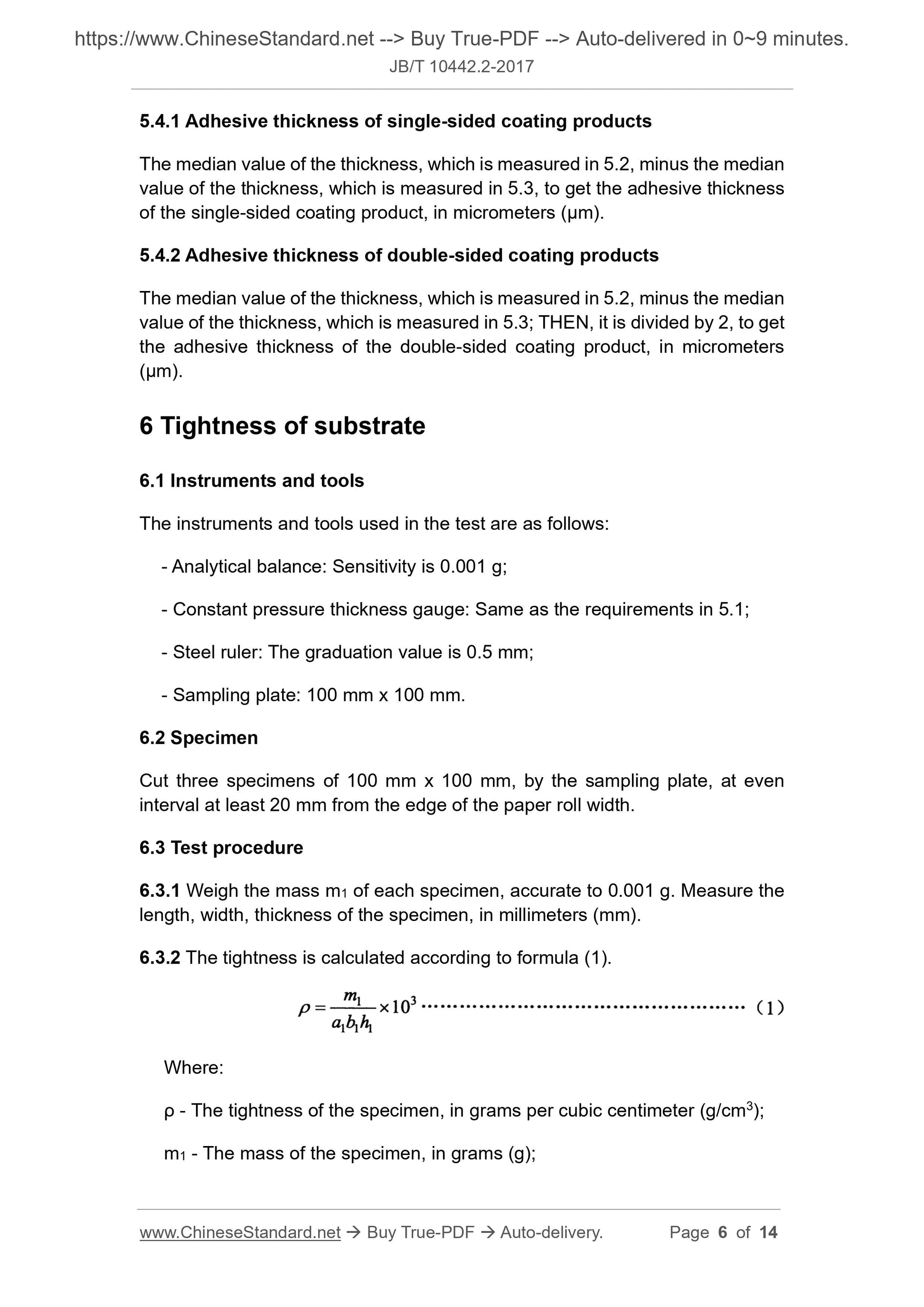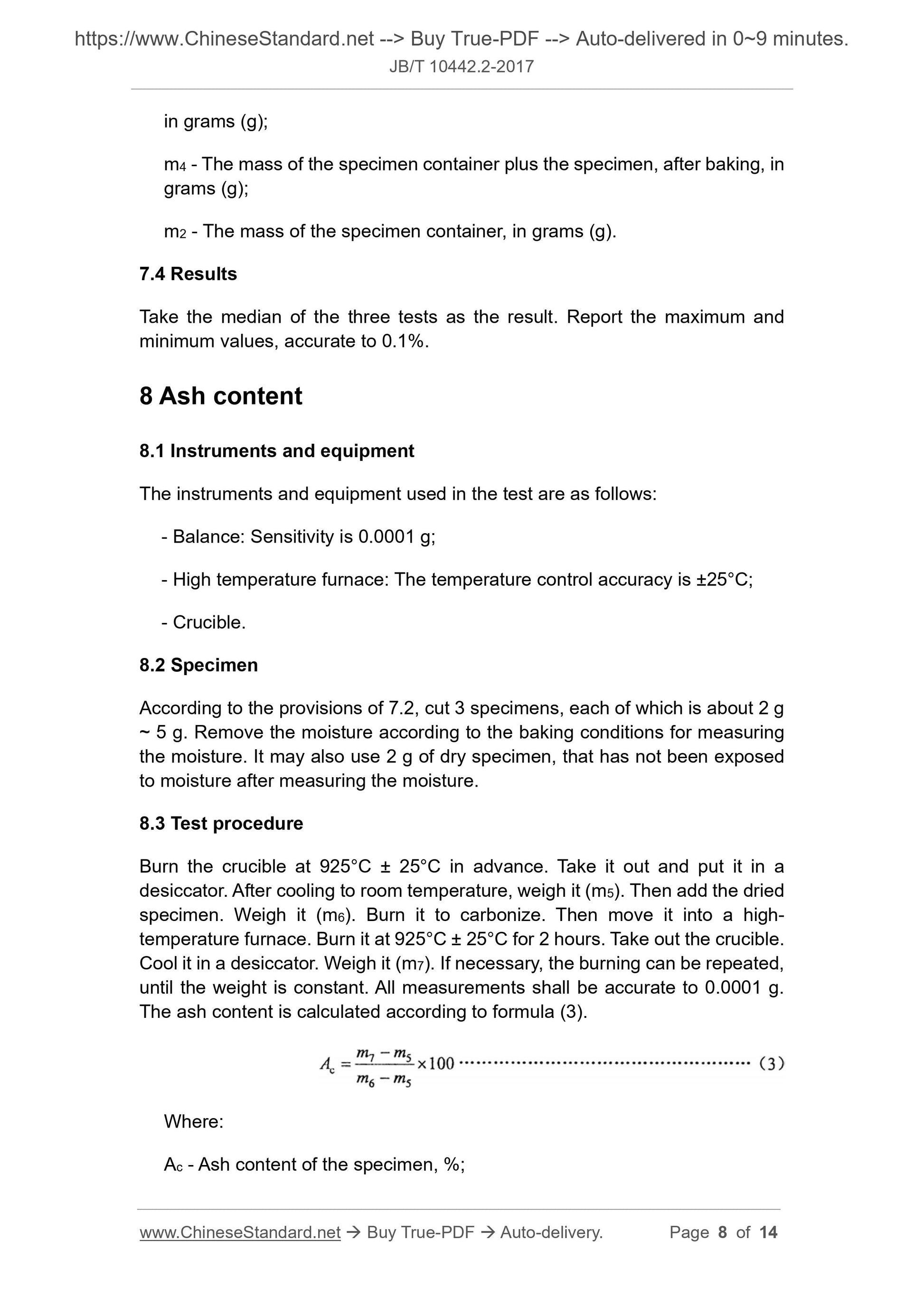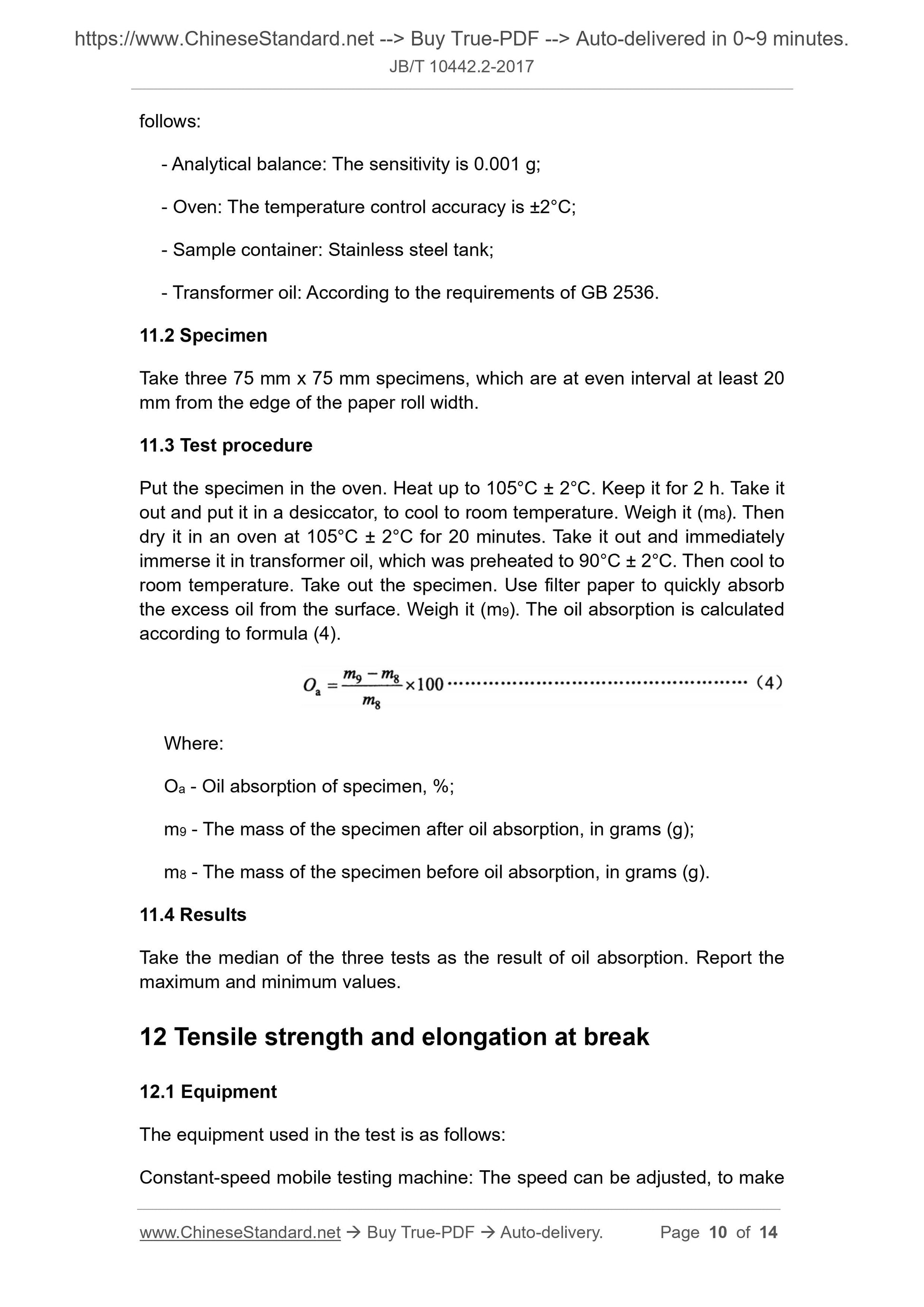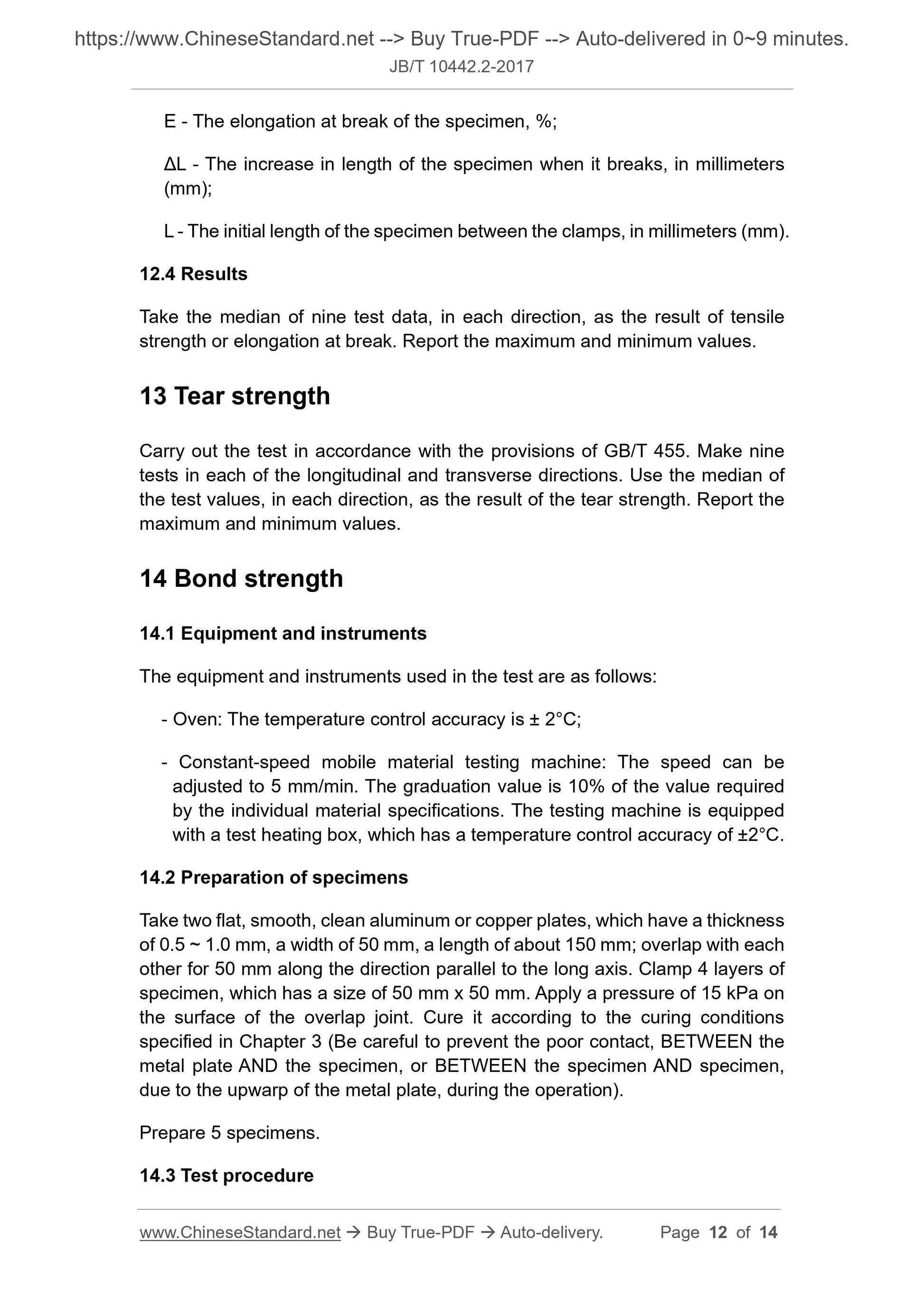1
/
of
7
PayPal, credit cards. Download editable-PDF & invoice in 1 second!
JB/T 10442.2-2017 English PDF (JB/T10442.2-2017)
JB/T 10442.2-2017 English PDF (JB/T10442.2-2017)
Regular price
$190.00 USD
Regular price
Sale price
$190.00 USD
Unit price
/
per
Shipping calculated at checkout.
Couldn't load pickup availability
Delivery: 3 seconds. Download true-PDF + Invoice.
Get QUOTATION in 1-minute: Click JB/T 10442.2-2017
Historical versions: JB/T 10442.2-2017
Preview True-PDF (Reload/Scroll if blank)
JB/T 10442.2-2017: Insulating paper coated with resin binder forming rhombic pattern for electrical purposes. Part 2: Methods of test
JB/T 10442.2-2017
JB
MECHANICAL INDUSTRY STANDARD
OF THE PEOPLE’S REPUBLIC OF CHINA
ICS 29.035.99
K 15
Filing No.: 58356-2017
Replacing JB/T 10442.2-2004
Insulating paper coated with resin binder forming
rhombic pattern for electrical purposes - Part 2:
Methods of test
ISSUED ON: APRIL 12, 2017
IMPLEMENTED ON: JANUARY 01, 2018
Issued by: Ministry of Industry and Information Technology of PRC
Table of Contents
Foreword ... 3
1 Scope ... 4
2 Normative references ... 4
3 General requirements for tests ... 4
4 Appearance ... 5
5 Thickness ... 5
6 Tightness of substrate ... 6
7 Moisture ... 7
8 Ash content ... 8
9 Conductivity of water extract ... 9
10 pH value of water extract ... 9
11 Oil absorption ... 9
12 Tensile strength and elongation at break... 10
13 Tear strength ... 12
14 Bond strength ... 12
15 Breakdown voltage ... 13
16 Contamination of transformer oil ... 14
Insulating paper coated with resin binder forming
rhombic pattern for electrical purposes - Part 2:
Methods of test
1 Scope
This part of JB/T 10442 specifies the test method of the insulating paper coated
with resin binder forming rhombic pattern for electrical purposes.
This part applies to insulating paper coated with resin binder forming rhombic
pattern for electrical purposes.
2 Normative references
The following documents are essential to the application of this document. For
the dated documents, only the versions with the dates indicated are applicable
to this document; for the undated documents, only the latest version (including
all the amendments) are applicable to this standard.
GB/T 451.3 Paper and board - Determination of thickness
GB/T 455 Paper and board - Determination of tearing resistance
GB/T 1408.1 Electrical strength of insulating materials - Test methods - Part
1: Tests at power frequencies
GB/T 1545 Paper board and pulp - Determination of acidity or alkalinity
GB 2536 Fluids for electrotechnical applications - Unused mineral insulating
oils for transformers and switchgear
GB/T 5654 Insulating liquids - Measurement of relative permittivity dielectric
dissipation factor (tanδ) and d.c. resistivity
GB/T 7196 Methods of test for the determination of ionic impurities in
electrical insulating materials by extraction with liquids
3 General requirements for tests
Unless otherwise specified, the samples shall be conditioned at 23°C ± 2°C and
5.4.1 Adhesive thickness of single-sided coating products
The median value of the thickness, which is measured in 5.2, minus the median
value of the thickness, which is measured in 5.3, to get the adhesive thickness
of the single-sided coating product, in micrometers (µm).
5.4.2 Adhesive thickness of double-sided coating products
The median value of the thickness, which is measured in 5.2, minus the median
value of the thickness, which is measured in 5.3; THEN, it is divided by 2, to get
the adhesive thickness of the double-sided coating product, in micrometers
(µm).
6 Tightness of substrate
6.1 Instruments and tools
The instruments and tools used in the test are as follows:
- Analytical balance: Sensitivity is 0.001 g;
- Constant pressure thickness gauge: Same as the requirements in 5.1;
- Steel ruler: The graduation value is 0.5 mm;
- Sampling plate: 100 mm x 100 mm.
6.2 Specimen
Cut three specimens of 100 mm x 100 mm, by the sampling plate, at even
interval at least 20 mm from the edge of the paper roll width.
6.3 Test procedure
6.3.1 Weigh the mass m1 of each specimen, accurate to 0.001 g. Measure the
length, width, thickness of the specimen, in millimeters (mm).
6.3.2 The tightness is calculated according to formula (1).
Where:
ρ - The tightness of the specimen, in grams per cubic centimeter (g/cm3);
m1 - The mass of the specimen, in grams (g);
in grams (g);
m4 - The mass of the specimen container plus the specimen, after baking, in
grams (g);
m2 - The mass of the specimen container, in grams (g).
7.4 Results
Take the median of the three tests as the result. Report the maximum and
minimum values, accurate to 0.1%.
8 Ash content
8.1 Instruments and equipment
The instruments and equipment used in the test are as follows:
- Balance: Sensitivity is 0.0001 g;
- High temperature furnace: The temperature control accuracy is ±25°C;
- Crucible.
8.2 Specimen
According to the provisions of 7.2, cut 3 specimens, each of which is about 2 g
~ 5 g. Remove the moisture according to the baking conditions for measuring
the moisture. It may also use 2 g of dry specimen, that has not been exposed
to moisture after measuring the moisture.
8.3 Test procedure
Burn the crucible at 925°C ± 25°C in advance. Take it out and put it in a
desiccator. After cooling to room temperature, weigh it (m5). Then add the dried
specimen. Weigh it (m6). Burn it to carbonize. Then move it into a high-
temperature furnace. Burn it at 925°C ± 25°C for 2 hours. Take out the crucible.
Cool it in a desiccator. Weigh it (m7). If necessary, the burning can be repeated,
until the weight is constant. All measurements shall be accurate to 0.0001 g.
The ash content is calculated according to formula (3).
Where:
Ac - Ash content of the specimen, %;
follows:
- Analytical balance: The sensitivity is 0.001 g;
- Oven: The temperature control accuracy is ±2°C;
- Sample container: Stainless steel tank;
- Transformer oil: According to the requirements of GB 2536.
11.2 Specimen
Take three 75 mm x 75 mm specimens, which are at even interval at least 20
mm from the edge of the paper roll width.
11.3 Test procedure
Put the specimen in the oven. Heat up to 105°C ± 2°C. Keep it for 2 h. Take it
out and put it in a desiccator, to cool to room temperature. Weigh it (m8). Then
dry it in an oven at 105°C ± 2°C for 20 minutes. Take it out and immediately
immerse it in transformer oil, which was preheated to 90°C ± 2°C. Then cool to
room temperature. Take out the specimen. Use filter paper to quickly absorb
the excess oil from the surface. Weigh it (m9). The oil absorption is calculated
according to formula (4).
Where:
Oa - Oil absorption of specimen, %;
m9 - The mass of the specimen after oil absorption, in grams (g);
m8 - The mass of the specimen before oil absorption, in grams (g).
11.4 Results
Take the median of the three tests as the result of oil absorption. Report the
maximum and minimum values.
12 Tensile strength and elongation at break
12.1 Equipment
The equipment used in the test is as follows:
Constant-speed mobile testing machine: The speed can be adjusted, to make
E - The elongation at break of the specimen, %;
ΔL - The increase in length of the specimen when it breaks, in millimeters
(mm);
L - The initial length of the specimen between the clamps, in millimeters (mm).
12.4 Results
Take the median of nine test data, in each direction, as the result of tensile
strength or elongation at break. Report the maximum and minimum values.
13 Tear strength
Carry out the test in accordance with the provisions of GB/T 455. Make nine
tests in each of the longitudinal and transverse directions. Use the median of
the test values, in each direction, as the result of the tear strength. Report the
maximum and minimum values.
14 Bond strength
14.1 Equipment and instruments
The equipment and instruments used in the test are as follows:
Get QUOTATION in 1-minute: Click JB/T 10442.2-2017
Historical versions: JB/T 10442.2-2017
Preview True-PDF (Reload/Scroll if blank)
JB/T 10442.2-2017: Insulating paper coated with resin binder forming rhombic pattern for electrical purposes. Part 2: Methods of test
JB/T 10442.2-2017
JB
MECHANICAL INDUSTRY STANDARD
OF THE PEOPLE’S REPUBLIC OF CHINA
ICS 29.035.99
K 15
Filing No.: 58356-2017
Replacing JB/T 10442.2-2004
Insulating paper coated with resin binder forming
rhombic pattern for electrical purposes - Part 2:
Methods of test
ISSUED ON: APRIL 12, 2017
IMPLEMENTED ON: JANUARY 01, 2018
Issued by: Ministry of Industry and Information Technology of PRC
Table of Contents
Foreword ... 3
1 Scope ... 4
2 Normative references ... 4
3 General requirements for tests ... 4
4 Appearance ... 5
5 Thickness ... 5
6 Tightness of substrate ... 6
7 Moisture ... 7
8 Ash content ... 8
9 Conductivity of water extract ... 9
10 pH value of water extract ... 9
11 Oil absorption ... 9
12 Tensile strength and elongation at break... 10
13 Tear strength ... 12
14 Bond strength ... 12
15 Breakdown voltage ... 13
16 Contamination of transformer oil ... 14
Insulating paper coated with resin binder forming
rhombic pattern for electrical purposes - Part 2:
Methods of test
1 Scope
This part of JB/T 10442 specifies the test method of the insulating paper coated
with resin binder forming rhombic pattern for electrical purposes.
This part applies to insulating paper coated with resin binder forming rhombic
pattern for electrical purposes.
2 Normative references
The following documents are essential to the application of this document. For
the dated documents, only the versions with the dates indicated are applicable
to this document; for the undated documents, only the latest version (including
all the amendments) are applicable to this standard.
GB/T 451.3 Paper and board - Determination of thickness
GB/T 455 Paper and board - Determination of tearing resistance
GB/T 1408.1 Electrical strength of insulating materials - Test methods - Part
1: Tests at power frequencies
GB/T 1545 Paper board and pulp - Determination of acidity or alkalinity
GB 2536 Fluids for electrotechnical applications - Unused mineral insulating
oils for transformers and switchgear
GB/T 5654 Insulating liquids - Measurement of relative permittivity dielectric
dissipation factor (tanδ) and d.c. resistivity
GB/T 7196 Methods of test for the determination of ionic impurities in
electrical insulating materials by extraction with liquids
3 General requirements for tests
Unless otherwise specified, the samples shall be conditioned at 23°C ± 2°C and
5.4.1 Adhesive thickness of single-sided coating products
The median value of the thickness, which is measured in 5.2, minus the median
value of the thickness, which is measured in 5.3, to get the adhesive thickness
of the single-sided coating product, in micrometers (µm).
5.4.2 Adhesive thickness of double-sided coating products
The median value of the thickness, which is measured in 5.2, minus the median
value of the thickness, which is measured in 5.3; THEN, it is divided by 2, to get
the adhesive thickness of the double-sided coating product, in micrometers
(µm).
6 Tightness of substrate
6.1 Instruments and tools
The instruments and tools used in the test are as follows:
- Analytical balance: Sensitivity is 0.001 g;
- Constant pressure thickness gauge: Same as the requirements in 5.1;
- Steel ruler: The graduation value is 0.5 mm;
- Sampling plate: 100 mm x 100 mm.
6.2 Specimen
Cut three specimens of 100 mm x 100 mm, by the sampling plate, at even
interval at least 20 mm from the edge of the paper roll width.
6.3 Test procedure
6.3.1 Weigh the mass m1 of each specimen, accurate to 0.001 g. Measure the
length, width, thickness of the specimen, in millimeters (mm).
6.3.2 The tightness is calculated according to formula (1).
Where:
ρ - The tightness of the specimen, in grams per cubic centimeter (g/cm3);
m1 - The mass of the specimen, in grams (g);
in grams (g);
m4 - The mass of the specimen container plus the specimen, after baking, in
grams (g);
m2 - The mass of the specimen container, in grams (g).
7.4 Results
Take the median of the three tests as the result. Report the maximum and
minimum values, accurate to 0.1%.
8 Ash content
8.1 Instruments and equipment
The instruments and equipment used in the test are as follows:
- Balance: Sensitivity is 0.0001 g;
- High temperature furnace: The temperature control accuracy is ±25°C;
- Crucible.
8.2 Specimen
According to the provisions of 7.2, cut 3 specimens, each of which is about 2 g
~ 5 g. Remove the moisture according to the baking conditions for measuring
the moisture. It may also use 2 g of dry specimen, that has not been exposed
to moisture after measuring the moisture.
8.3 Test procedure
Burn the crucible at 925°C ± 25°C in advance. Take it out and put it in a
desiccator. After cooling to room temperature, weigh it (m5). Then add the dried
specimen. Weigh it (m6). Burn it to carbonize. Then move it into a high-
temperature furnace. Burn it at 925°C ± 25°C for 2 hours. Take out the crucible.
Cool it in a desiccator. Weigh it (m7). If necessary, the burning can be repeated,
until the weight is constant. All measurements shall be accurate to 0.0001 g.
The ash content is calculated according to formula (3).
Where:
Ac - Ash content of the specimen, %;
follows:
- Analytical balance: The sensitivity is 0.001 g;
- Oven: The temperature control accuracy is ±2°C;
- Sample container: Stainless steel tank;
- Transformer oil: According to the requirements of GB 2536.
11.2 Specimen
Take three 75 mm x 75 mm specimens, which are at even interval at least 20
mm from the edge of the paper roll width.
11.3 Test procedure
Put the specimen in the oven. Heat up to 105°C ± 2°C. Keep it for 2 h. Take it
out and put it in a desiccator, to cool to room temperature. Weigh it (m8). Then
dry it in an oven at 105°C ± 2°C for 20 minutes. Take it out and immediately
immerse it in transformer oil, which was preheated to 90°C ± 2°C. Then cool to
room temperature. Take out the specimen. Use filter paper to quickly absorb
the excess oil from the surface. Weigh it (m9). The oil absorption is calculated
according to formula (4).
Where:
Oa - Oil absorption of specimen, %;
m9 - The mass of the specimen after oil absorption, in grams (g);
m8 - The mass of the specimen before oil absorption, in grams (g).
11.4 Results
Take the median of the three tests as the result of oil absorption. Report the
maximum and minimum values.
12 Tensile strength and elongation at break
12.1 Equipment
The equipment used in the test is as follows:
Constant-speed mobile testing machine: The speed can be adjusted, to make
E - The elongation at break of the specimen, %;
ΔL - The increase in length of the specimen when it breaks, in millimeters
(mm);
L - The initial length of the specimen between the clamps, in millimeters (mm).
12.4 Results
Take the median of nine test data, in each direction, as the result of tensile
strength or elongation at break. Report the maximum and minimum values.
13 Tear strength
Carry out the test in accordance with the provisions of GB/T 455. Make nine
tests in each of the longitudinal and transverse directions. Use the median of
the test values, in each direction, as the result of the tear strength. Report the
maximum and minimum values.
14 Bond strength
14.1 Equipment and instruments
The equipment and instruments used in the test are as follows:
Share
